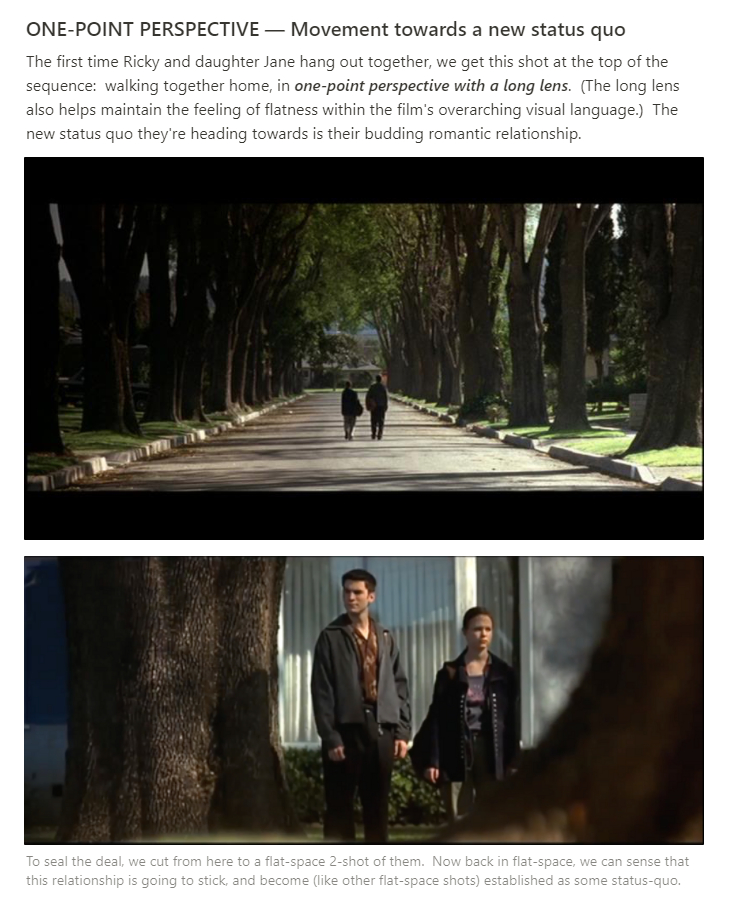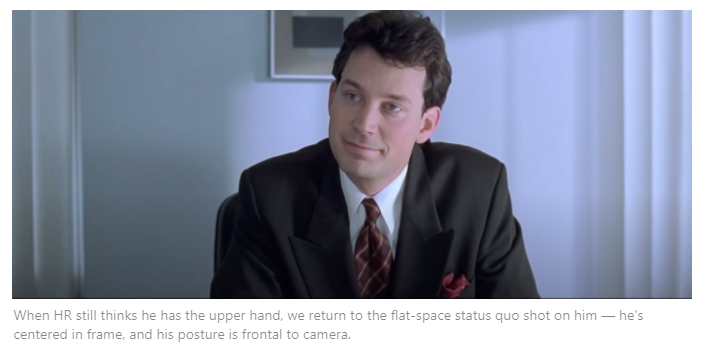theres so much good advice for #storyboarding more ~dynamic~ shots! but tbh I sometimes find myself fiending to make EVERY shot dynamic, and end up diluting the impact & meaning
so lets talk FLAT SHOTS! Creating subtext! tension! & visual language! [a thread] #film #feboardary
so lets talk FLAT SHOTS! Creating subtext! tension! & visual language! [a thread] #film #feboardary

lol so yeah Wes Anderson gets a lot of (aptly deserved) attention for his gorgeous use of flat shots, but I wanted to shed some light on a film that holds a few more surprises in the flat-space department: American Beauty (1999, dir Sam Mendes, DP Conrad Hall)
I mean, this film is chock FULL of gorgeous flat shots, and all expertly designed to give us a TON of story information in each image. Here are some faves: 







Visual language changes film to film. Tho we usually think of up-shots as powerful, down-shots as vulnerable, flat shots as placid, deep-space shots as dynamic; these aren't hard rules. In fact, the director's job is to invent new visual rules with each/entire film!
American Beauty is a story about a reawakening from stagnation, strangers, and allll their consequences. In this particular film, these are some of the things that a flat-space shot is made to represent: 

So, are we saying ""wow the whole entire film is shot flat, and that means yay it's good bc we did 1 thing for 2 hrs""?
nah dude
nah dude
bc Mendes & Hall establish a consistent flatness thru/out the film, whenever they break that pattern with a dynamic shot, they immediately grab our attention! & boy do they!
the dynamic shot plays MORE dramatic & tense bc it CONTRASTS with the 2h of flatness!!
the dynamic shot plays MORE dramatic & tense bc it CONTRASTS with the 2h of flatness!!
Indeed, other motifs and meanings arise as they side-step from the flatness. for one, typically associating dynamic shots with the neighbor boy
(so, now there's this other pattern to where they -break- the flatness... a pattern over a pattern if you will!)



(so, now there's this other pattern to where they -break- the flatness... a pattern over a pattern if you will!)




Compare the 2 office scenes, esp the power dynamics & how they change. Notice how flat the scene is here, when he's trapped, stagnant, powerless...
vs how much more dynamic & off-center the shots are now- SUBTEXT GALORE!



vs how much more dynamic & off-center the shots are now- SUBTEXT GALORE!




now heres one of the few scenes w/ violence & overt tension, and the 1 and ONLY scene using hand-held shots. Cam is way more dynamic off the bat. & bc the rest of the film was so tightly controlled w/ flat shots, tension here really stands out!
And here's where I think this gets even cooler: What if you used FLAT SPACE to shoot another one of the most TENSE moments in the film??
It's Act 3, & here's what I'm talkin bout- (damn spoilers in the video title but ok)
It's Act 3, & here's what I'm talkin bout- (damn spoilers in the video title but ok)
so, right before this scene, the Colonel had secretly witnessed, thru the garage window, what looked like his son being exploited by the neighbor Lester (KS). Now, the cold-blooded Colonel heads next door to confront him...
And yet, the scene stays flat! Why??



And yet, the scene stays flat! Why??




Flat shots here actually spell MORE intensity than dynamic ones, bc they reflect Lester's UNAWARENESS of the danger he's in, which puts him in even MORE danger
That dramatic irony is TENSE. The audience experiences the terror FOR him: "Run away! Stop the small talk!"


That dramatic irony is TENSE. The audience experiences the terror FOR him: "Run away! Stop the small talk!"



As Hitchcock once said, ""there is no terror in the bang, only in the anticipation of it."
By now, we have learned Mendes' visual language of flat/deep, & we anticipate a deep dynamic shot the same way we anticipate the bang. Draw out the tension - withhold the bang!
By now, we have learned Mendes' visual language of flat/deep, & we anticipate a deep dynamic shot the same way we anticipate the bang. Draw out the tension - withhold the bang!
And then here's the other thing- when u reinvent the meaning of certain shot types, & UPHOLD that meaning thru/out the ENTIRE film, ur creating a visual language!
and u can really say so much more as filmmaker if u think beyond cramming subtext into 1 shot
and u can really say so much more as filmmaker if u think beyond cramming subtext into 1 shot
Visual language is where deep, rich subtext is created -- over SEVERAL shots & sequences, not just 1!
THIS is the invisible glue (the ether btwn the frames) that makes a film WHOLE. and tbh this is what I had the hardest time finding/learning when I started boarding
THIS is the invisible glue (the ether btwn the frames) that makes a film WHOLE. and tbh this is what I had the hardest time finding/learning when I started boarding
I can't recommend this enough: Bruce Block's Visual Story book digs deep into the many different ways u can analyze or create ur own visual language (which is what inspired this film study!). Or watch this film urself & lmk what you find too!
Me reading Bruce Block:
Me reading Bruce Block:

• • •
Missing some Tweet in this thread? You can try to
force a refresh


















